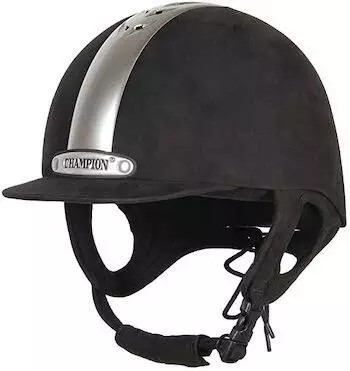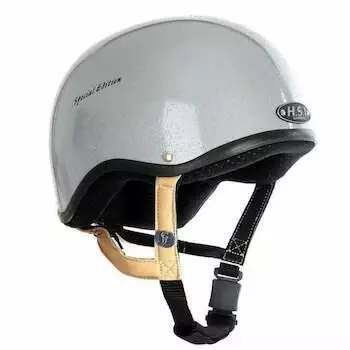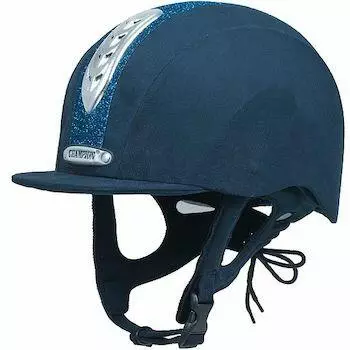It’s easy to look at a riding helmet and think, ‘oh yeah, that looks sturdy and secure’ but you need to remember this isn’t any old piece of equipment.
This is something which could very well save your life!
It’s therefore imperative that you do plenty of research into not just the comforting features or colours of a helmet, but also whether it can offer the sufficient protection you need.
Things to Consider
Safety & Standards Testing
We know you already know this, but it’s worth reminding you that the absolute most imperative thing when purchasing any riding helmet is to make sure it can provide you with the safety and protection you need.
The easiest way to know if your helmet is suitable is by looking to see what safety standards it has passed, and it should have at the very least a CE marking, indicating it has passed safety standards by European law.
We however always recommend looking out for a helmet which also has a BSI Kitemark.
While CE markings are the minimum you need to look for, the BSI Kitemark is a far more reassuring certification that shows the product makers have gone beyond the minimum to ensure their products are fully tested.
To gain a BSI kitemark, manufacturers must have their production and product performance rigorously tested and have all their performance claims challenged.
So if your helmet has one, you can rest assured it’s going to fulfil every single one of its promises.
Many UK riding schools, national clubs and competitions also only allow riders to take part if they are sporting a BSI Kitemarked riding hat, so it’s always best to prioritise them.
They will often see them described as PAS 015 1998/2011(Product Approval Specifications).
The 2011 edition is the updated and best choice and offers far more protection and quality than the original certification.
Suitable For Your Activity
You might assume a riding hat is suitable for all horse riding activity, but while many cover everything from racing to showjumping, you’ll occasionally find in the small print that certain helmets only cover the safety standards for a limited amount of activities.
It’s therefore important to always check this out, especially if you’re going to be doing a high-intensity form of horse riding with more risks of falls and damage.
Protection
The whole reason you’re wearing a helmet in the first place is to protect your head from injury. Make sure whatever you buy promises a strong and durable material which will take all the impact of a fall and keep your head free from harm. This is why making sure your helmet has a safety certification or kitemark is so important, as it means you can rest assured your helmet will prevent serious injury.
Size
Once you’re a little more clued up on safety standards and materials, you of course then need to ensure whatever helmet you choose is the perfect fit for your head type.
You should never roughly guess what size you are and you’ll need to take an accurate measurement of the circumference of your head with a tape measure to help you choose the correct size.
After getting your measurement, you then want to try and pick a size which fits firmly but is still comfortable. It’s all about finding the balance and avoiding discomforting pressure or it being too loose.
In general, you should always pick as close a fit as possible as over time the lining will become more compressed and fit better anyway. You, therefore, shouldn’t really be choosing anything smaller or too much bigger than the natural circumference of your head.
You’ll know you’ve made the right choice if there’s a slight suction when removed and a gentle pulling on the skin above the eyebrows.
It should also sit atop your head without rocking side to side or slipping when you move.
Types of Hat
Single Size
These are the most commonly used riding hats and are individually fitted to the rider, allowing you to get the most unique fit.
Although this guarantees you a secure and comfortable hat, it obviously takes a lot more effort to seek out and find the perfect choice for you!
Adjustable
These, much like they say on the tin, offer a lot more compatibility than a single size.
They’re especially good if choosing a child helmet, as it allows your helmet to grow with you!
They also happen to fit round or oval-shaped helmets slightly better and incorporate more modern features like detachable and washable interiors or good ventilation.
However, there is also the risk you may not adjust them to the correct size and risk your security.
Styles of Hat
As mentioned previously, certain styles of helmets perform better based on the intensity and type of riding you take part in and so you should really choose a style which will benefit that activity.
Standard Riding Hat
These are the most common type of hat and are used for showjumping and dressage, often offering plenty of design and colours. They sit on the top part of the head and have a peak or brim.
Skull Helmet
These are essential for jockeys, hunters and eventers as they offer more head coverage along the back and sides. They also don’t feature a peak or brim as these can cause injury should you fall at high speeds.
Although they offer a lot more protection, they tend to as a result have a little less customisation and colour. They certainly value safety over style!
Features to Look Out For
Hat Shape
If all riding hats were the same, no company would be able to offer any unique selling points, features or styles.
Therefore most brands of horse riding helmet tend to come in all sorts of individual shapes, which unfortunately means some brands suit certain heads better than others.
The only real way to solve which brands match up best with you is to experiment with a selection of them and try to get a feel for who’s helmets mould with your head.
Rocking and movement of the helmet is usually the key sign that your helmet is not a very accommodating shape for your head.
If it moves from side to side and you have a tight forehead, it means it is too round and you need a more oval-shaped design.
Rocking front to back means you need a rounder shape.
Hat Finish/ Materials
Once all the most important things have been taken into consideration the look and finish of your hat. The traditional look is obviously a velvet finish but these days there is an almost endless list of options for you to choose from. ABS plastic, carbon fibre or glass fibre finishes are very popular with more modern style helmets, but you can even have fashionable materials like leather and suede!
Unfortunately, it doesn’t really seem to matter what finish you pick in terms of anti-wear, as all hats seem to be susceptible to scratches and minor markings. This means there isn’t really any point paying over the odds for a carbon fibre option say, as there’s no guarantee it will give you any more longevity than a plastic one.
Retention Harness/ Chinstrap
Everyone just sort of assumes a chinstrap is always going to perform its job well, forgetting that it’s an absolutely vital part of the hat – as it helps keep it on your head!
In terms of fitting, it should feel secure around the chin and you should only ever be able to fit one finger between the skin and the strap.
There is then the harness to consider, which often comes in either 3 or 4 point designs. These points refer to the points at which the hat can be adjusted for the best fit, helping you find the optimum feel for you.
Lightweight/ Low Profile
Sometimes when people read a riding hat is lightweight, they worry this means it won’t offer the same kind of protection. But slimmer, less heavy helmets can still provide the same level of security as a weighty model provided they’re of high quality. After all, you don’t want to feel like you’re wearing a diving suit helmet!
Removable Liner
Given how hot it can get under those helmets, the lining of your hat can get a bit dirty over time!
Thankfully, removable liners can help you regularly wash the inside of your helmet and crucially it means if the padding ever wears out – you can buy a new liner and not a whole new helmet!
It also offers a bit more customisation in terms of finding the right fit and comfort. If your helmet feels too tight, perhaps swapping your insert for thinner padding will help make things more snuggly!
Ventilation
If you struggle with heat and discomfort when wearing helmets for very long periods of time, finding a riding hat with a good source of ventilation can help prevent a horrible sweaty experience!
Adjustable Dial
Often found at the back of adjustable model hats these can be beneficial for more than just creating a more personalised fit.
They can also make accommodating ponytails a lot easier if you’re a long-haired rider and during winter months it can allow you to create a bit more space for balaclavas and scarves for warmth.









